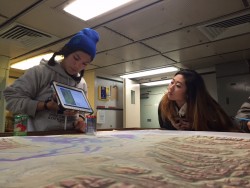
The students arrived at Pier 90 on Seattle’s waterfront just after sunrise. The skies above downtown were painted pink and orange, but clouds loomed in the distance. They hinted at what would be a cold, wet day at sea. But neither the early hour or impending weather could dampen the mood.
To prepare for this moment, students in Charles Nittrouer’s Rivers and Beaches class had spent months studying Earth’s surfaces, what forms and shapes them, and what roles humans play in those processes. Looking at the links between landscapes and seascapes, they focused on mountains, rivers, beaches, deltas, and estuaries.
“We live on those mountains, plains, and near rivers,” Sarah Schanz, co-instructor of last fall’s “Rivers and Beaches” class and graduate student at UW’s College of the Environment said. “We need to know how they’re formed to better assess risk to our communities and to predict future risk.”

Throughout the quarter, students took a deeper dive into the science through a series of field experiences. Their day-long Puget Sound cruise was the last in a series of trips tracing the path of the Nisqually River, from its headwaters at Mt. Rainier to where it flows into the sea south of Olympia, Wash.
To explore the mouth of the river and its features, students climbed aboard the RV Thomas G. Thompson.
“Getting to go on the Thompson is not something that a lot of classes get to do, and especially being in an introductory class. This is a really amazing thing to experience,” Cleo Woodcock, an undergraduate in Environmental Studies said.
The 274-foot-long ship can accommodate nearly 60 people for extended trips. It’s owned by the United States Navy, but functionally operated and maintained by the University of Washington. Utilized by research institutions from across the country, the RV Thompson spends the year deployed in various reaches of the world’s ocean.
Once out on the open water, Nittrouer’s students saw first-hand how onboard equipment is used to take sand grabs, water, and sediment samples, how and what data can be extracted from the materials they had collected, and explored what their results might indicate about the unique processes at play.

“[The trip] helped me conceptualize the scope of science that you can do and the infrastructure and logistics that go into the finished results of papers,” Woodcock said. “It takes a lot of resources to do science, gather the data, and analyze it.”
Offered jointly through the Department of Earth and Space Sciences and the School of Oceanography, “Rivers and Beaches” is unique in that it’s open to all students, including underclassmen, undeclared majors, and those studying outside of the College of the Environment.
“You don’t know you like something until you try it! We get people from all sorts of departments and backgrounds, and it actually increases the quality of the class, and especially class discussions, to get so many different viewpoints,” Schanz said. “It also helps us reach more people, who now have an introductory knowledge on these subjects that they can carry on and hopefully incorporate into their future work and lives.”

